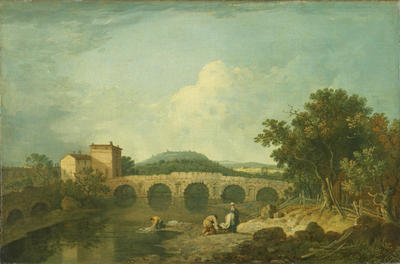Roman Bridge at Rimini
Artist and role
Wilson, Richard (Welsh, b.1714, d.1782)
See full details
About this work
From 1758 to 1765 William Hodges (1744–97), the official artist on Captain James Cook’s second South Pacific voyage, was apprenticed to Richard Wilson, who painted this gentle Italianate landscape. In depicting the awesome and exotic scenery of New Zealand and the Pacific, Hodges was strongly influenced by Wilson’s Classically inspired compositions, though he added all the gusto of a Romantic sensibility, informed by the Sublime, to create his famously evocative antipodean paintings. In his 1790 biographical essay on Wilson, Hodges wrote, ‘the classical turn of thinking in his works, and the broad, bold and manly execution of them; which, added to the classical figures he introduced into his landscapes, gave them an air more agreeable to the taste of the true connoisseurs and men of learning’.
Indeed Wilson, the educated gentleman son of a Welsh clergyman, positioned himself and his art perfectly to suit the tastes and attitudes of his aristocratic British patrons. Originally a portrait painter, in 1752 he turned his attention to landscape while in Italy, where he worked from 1750 until 1757, in Venice, Rome and their environs, studying the old masters and antiquities, and mixing with other artists and potential patrons on their Grand Tour. Although informed by the Classical elements of Claude, Poussin, Rosa and Jan Frans van Bloemen, his painting nevertheless reveals a genuine feeling for nature. Broad vistas, big luminous skies, topographical features, delicately craggy tree clusters, buildings, ruins and foreground figures are all choreographed beautifully in his interpretation of landscape.
Back in London, Wilson applied his elevated style to the British landscape. He was at the height of his powers between 1760 and 1768, but by 1772 his reputation had diminished, though his paintings continued to be collected and were inspirational to future generations of artists, including Hodges and J M W Turner, who as a young man is known to have admired Wilson’s work.
Indeed Wilson, the educated gentleman son of a Welsh clergyman, positioned himself and his art perfectly to suit the tastes and attitudes of his aristocratic British patrons. Originally a portrait painter, in 1752 he turned his attention to landscape while in Italy, where he worked from 1750 until 1757, in Venice, Rome and their environs, studying the old masters and antiquities, and mixing with other artists and potential patrons on their Grand Tour. Although informed by the Classical elements of Claude, Poussin, Rosa and Jan Frans van Bloemen, his painting nevertheless reveals a genuine feeling for nature. Broad vistas, big luminous skies, topographical features, delicately craggy tree clusters, buildings, ruins and foreground figures are all choreographed beautifully in his interpretation of landscape.
Back in London, Wilson applied his elevated style to the British landscape. He was at the height of his powers between 1760 and 1768, but by 1772 his reputation had diminished, though his paintings continued to be collected and were inspirational to future generations of artists, including Hodges and J M W Turner, who as a young man is known to have admired Wilson’s work.
Measurements
470 x 720 mm sight size; 655 x 905 mm frame size
Artist
Credit
Collection of the Dunedin Public Art Gallery. Purchased 1947 with funds from the Dunedin Public Art Gallery Society through the National Art Collections Fund, London.
Accession number
7-1947


